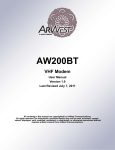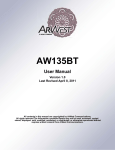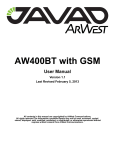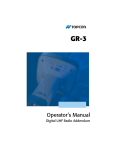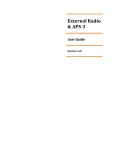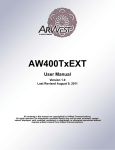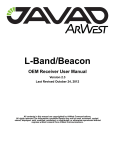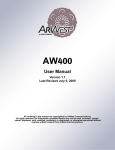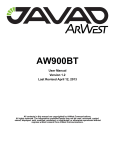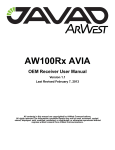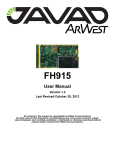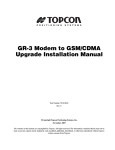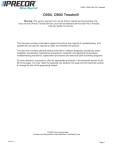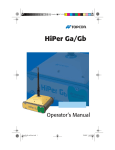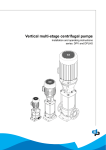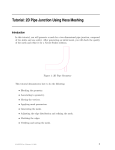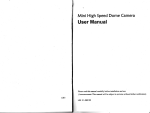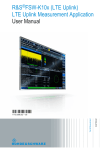Download ArWest AW435BT User Manual
Transcript
AW435BT User Manual Version 1.0 Last Revised January 12, 2011 All contents in this manual are copyrighted by ArWest Communications. All rights reserved.The information contained herein may not be used, accessed, copied, stored, displayed, sold, modified, published, or distributed, or otherwise reproduced without express written consent from ArWest Communications. www.arwestcom.com TABLE OF CONTENTS Preface . . . . . . . . . . . . . . . . . . . . . . . . . . . . . . . . . . . . . . . . . . . . . . . . . . . . . . . . .5 Terms and Conditions. . . . . . . . . . . . . . . . . . . . . . . . . . . . . . . . . . . . . . . . . . . . . . . . . . . . . . . . 5 Regulatory Information . . . . . . . . . . . . . . . . . . . . . . . . . . . . . . . . . . . . . . . . . . . . . . . . . . . . . . 7 FCC Class A Compliance . . . . . . . . . . . . . . . . . . . . . . . . . . . . . . . . . . . . . . . . . . . . . . . . . 7 Canadian Emissions Labeling Requirements . . . . . . . . . . . . . . . . . . . . . . . . . . . . . . . . . . 7 WEEE Directive . . . . . . . . . . . . . . . . . . . . . . . . . . . . . . . . . . . . . . . . . . . . . . . . . . . . . . . . 7 Screen Captures . . . . . . . . . . . . . . . . . . . . . . . . . . . . . . . . . . . . . . . . . . . . . . . . . . . . . . . . . . . . 9 Technical Assistance . . . . . . . . . . . . . . . . . . . . . . . . . . . . . . . . . . . . . . . . . . . . . . . . . . . . . . . . 9 Return Material Authorization . . . . . . . . . . . . . . . . . . . . . . . . . . . . . . . . . . . . . . . . . . . . . . . . . 9 Chapter 1. Introduction . . . . . . . . . . . . . . . . . . . . . . . . . . . . . . . . . . . . . . . . . . .11 1.1. Getting Acquainted . . . . . . . . . . . . . . . . . . . . . . . . . . . . . . . . . . . . . . . . . . . . . . . . . . . . . 12 1.1.1. LEDs . . . . . . . . . . . . . . . . . . . . . . . . . . . . . . . . . . . . . . . . . . . . . . . . . . . . . . . . . . . 12 1.1.2. Data and Power Ports . . . . . . . . . . . . . . . . . . . . . . . . . . . . . . . . . . . . . . . . . . . . . . 12 1.1.3. External Antenna and Bluetooth Antenna Connectors . . . . . . . . . . . . . . . . . . . . . 13 1.1.4. Mounting Bracket . . . . . . . . . . . . . . . . . . . . . . . . . . . . . . . . . . . . . . . . . . . . . . . . . 13 1.1.5. Cables . . . . . . . . . . . . . . . . . . . . . . . . . . . . . . . . . . . . . . . . . . . . . . . . . . . . . . . . . . 13 1.1.6. Literature . . . . . . . . . . . . . . . . . . . . . . . . . . . . . . . . . . . . . . . . . . . . . . . . . . . . . . . . 14 1.1.7. External Antenna (not included) . . . . . . . . . . . . . . . . . . . . . . . . . . . . . . . . . . . . . . 14 1.1.8. Storage Precautions . . . . . . . . . . . . . . . . . . . . . . . . . . . . . . . . . . . . . . . . . . . . . . . . 14 Chapter 2. Configuration. . . . . . . . . . . . . . . . . . . . . . . . . . . . . . . . . . . . . . . . . .15 2.1. Powering AW435BT . . . . . . . . . . . . . . . . . . . . . . . . . . . . . . . . . . . . . . . . . . . . . . . . . . . . 15 2.1.1. Power supply requirements . . . . . . . . . . . . . . . . . . . . . . . . . . . . . . . . . . . . . . . . . . 15 2.2. Antenna Installation. . . . . . . . . . . . . . . . . . . . . . . . . . . . . . . . . . . . . . . . . . . . . . . . . . . . . 16 2.3. Installing AWLaunch. . . . . . . . . . . . . . . . . . . . . . . . . . . . . . . . . . . . . . . . . . . . . . . . . . . . 18 2.4. Connecting AW435BT and Computer . . . . . . . . . . . . . . . . . . . . . . . . . . . . . . . . . . . . . . 19 2.4.1. Serial Connection . . . . . . . . . . . . . . . . . . . . . . . . . . . . . . . . . . . . . . . . . . . . . . . . . 19 2.4.2. USB Connection . . . . . . . . . . . . . . . . . . . . . . . . . . . . . . . . . . . . . . . . . . . . . . . . . . 19 2.4.3. Bluetooth® connection . . . . . . . . . . . . . . . . . . . . . . . . . . . . . . . . . . . . . . . . . . . . . 20 2.5. Configuring AW435BT . . . . . . . . . . . . . . . . . . . . . . . . . . . . . . . . . . . . . . . . . . . . . . . . . . 21 2.5.1. Simplex Protocol . . . . . . . . . . . . . . . . . . . . . . . . . . . . . . . . . . . . . . . . . . . . . . . . . . 23 2.5.2. Half-Duplex Protocol . . . . . . . . . . . . . . . . . . . . . . . . . . . . . . . . . . . . . . . . . . . . . . 26 2.6. Data Port Configuration. . . . . . . . . . . . . . . . . . . . . . . . . . . . . . . . . . . . . . . . . . . . . . . . . . 27 www.arwestcom.com 3 2.7. Checking Firmware Version. . . . . . . . . . . . . . . . . . . . . . . . . . . . . . . . . . . . . . . . . . . . . . 28 2.8. Loading New Firmware . . . . . . . . . . . . . . . . . . . . . . . . . . . . . . . . . . . . . . . . . . . . . . . . . 29 2.9. Bluetooth Configuration . . . . . . . . . . . . . . . . . . . . . . . . . . . . . . . . . . . . . . . . . . . . . . . . . . . . . . . . .30 Chapter 3. Command Line Interface . . . . . . . . . . . . . . . . . . . . . . . . . . . . . . . . 31 3.1. Command Line Interface Convention. . . . . . . . . . . . . . . . . . . . . . . . . . . . . . . . . . . . . . . 3.1.1. Software Switching to Command Mode . . . . . . . . . . . . . . . . . . . . . . . . . . . . . . . 3.1.2. Hardware Switching to Command Mode . . . . . . . . . . . . . . . . . . . . . . . . . . . . . . . 3.1.3. Switching to Data Mode. . . . . . . . . . . . . . . . . . . . . . . . . . . . . . . . . . . . . . . . . . . . 32 32 33 33 3.2. Networking Commands . . . . . . . . . . . . . . . . . . . . . . . . . . . . . . . . . . . . . . . . . . . . . . . . . 34 3.2.1. LINK. . . . . . . . . . . . . . . . . . . . . . . . . . . . . . . . . . . . . . . . . . . . . . . . . . . . . . . . . . . 34 3.3. Serial Interfacing Commands . . . . . . . . . . . . . . . . . . . . . . . . . . . . . . . . . . . . . . . . . . . . . 35 3.3.1. DPORT . . . . . . . . . . . . . . . . . . . . . . . . . . . . . . . . . . . . . . . . . . . . . . . . . . . . . . . . . 35 3.3.2. MPORT . . . . . . . . . . . . . . . . . . . . . . . . . . . . . . . . . . . . . . . . . . . . . . . . . . . . . . . . 36 3.4. Special Commands . . . . . . . . . . . . . . . . . . . . . . . . . . . . . . . . . . . . . . . . . . . . . . . . . . . . . 3.4.1. BOOT . . . . . . . . . . . . . . . . . . . . . . . . . . . . . . . . . . . . . . . . . . . . . . . . . . . . . . . . . . 3.4.2. HELP . . . . . . . . . . . . . . . . . . . . . . . . . . . . . . . . . . . . . . . . . . . . . . . . . . . . . . . . . . 3.4.3. SAVE . . . . . . . . . . . . . . . . . . . . . . . . . . . . . . . . . . . . . . . . . . . . . . . . . . . . . . . . . . 3.4.4. SLEEP . . . . . . . . . . . . . . . . . . . . . . . . . . . . . . . . . . . . . . . . . . . . . . . . . . . . . . . . . 37 37 37 37 38 3.5. Diagnostics and Identification Commands . . . . . . . . . . . . . . . . . . . . . . . . . . . . . . . . . . . 38 3.5.1. INFO. . . . . . . . . . . . . . . . . . . . . . . . . . . . . . . . . . . . . . . . . . . . . . . . . . . . . . . . . . . 38 3.5.2. STATE . . . . . . . . . . . . . . . . . . . . . . . . . . . . . . . . . . . . . . . . . . . . . . . . . . . . . . . . . 39 Appendix A. Specifications . . . . . . . . . . . . . . . . . . . . . . . . . . . . . . . . . . . . . . . 41 A.1. AW435BT UHF Modem Specifications . . . . . . . . . . . . . . . . . . . . . . . . . . . . . . . . . . . . A.1.1. General Radio Specifications . . . . . . . . . . . . . . . . . . . . . . . . . . . . . . . . . . . . . . . A.1.2. Environmental Specifications . . . . . . . . . . . . . . . . . . . . . . . . . . . . . . . . . . . . . . . A.1.3. Transmitter Specifications. . . . . . . . . . . . . . . . . . . . . . . . . . . . . . . . . . . . . . . . . . A.1.4. Receiver Specifications . . . . . . . . . . . . . . . . . . . . . . . . . . . . . . . . . . . . . . . . . . . . 41 41 42 42 43 A.2. Compliance . . . . . . . . . . . . . . . . . . . . . . . . . . . . . . . . . . . . . . . . . . . . . . . . . . . . . . . . . . 44 A.3. Connector Specifications . . . . . . . . . . . . . . . . . . . . . . . . . . . . . . . . . . . . . . . . . . . . . . . . 44 Appendix B. UHF Radio Usage . . . . . . . . . . . . . . . . . . . . . . . . . . . . . . . . . . . . 47 Appendix C. Safety Warnings . . . . . . . . . . . . . . . . . . . . . . . . . . . . . . . . . . . . . 49 C.1. General Warnings. . . . . . . . . . . . . . . . . . . . . . . . . . . . . . . . . . . . . . . . . . . . . . . . . . . . . . 49 C.2. Power Supply . . . . . . . . . . . . . . . . . . . . . . . . . . . . . . . . . . . . . . . . . . . . . . . . . . . . . . . . . 50 C.3. Usage Warnings . . . . . . . . . . . . . . . . . . . . . . . . . . . . . . . . . . . . . . . . . . . . . . . . . . . . . . . 50 Appendix D. Warranty Terms . . . . . . . . . . . . . . . . . . . . . . . . . . . . . . . . . . . . . 51 4 www.arwestcom.com PREFACE Thank you for purchasing this product. The materials available in this Manual (the “Manual”) have been prepared by ArWest Communications (“ArWest”) for owners of ArWest Communications products. It is designed to assist owners with the use of the AW435BT and its use is subject to these terms and conditions (the “Terms and Conditions”). Note: Please read these Terms and Conditions carefully. Terms and Conditions COPYRIGHT – All information contained in this Manual is the intellectual property of, and copyrighted material of ArWest Communications. All rights are reserved. You may not use, access, copy, store, display, create derivative works of, sell, modify, publish, distribute, or allow any third party access to, any graphics, content, information or data in this Manual without ArWest Communications’ express written consent and may only use such information for the care and operation of your AW435BT. The information and data in this Manual are a valuable asset of ArWest Communications and are developed by the expenditure of considerable work, time and money, and are the result of original selection, coordination and arrangement by ArWest Communications. TRADEMARKS – AW435BTTM, ArWest Communications® are trademarks or registered trademarks of ArWest Communications. Windows® is a registered trademark of Microsoft Corporation. Bluetooth® word mark is owned by the Bluetooth SIG, Inc. Product and company names mentioned herein may be trademarks of their respective owners. DISCLAIMER OF WARRANTY – EXCEPT FOR ANY WARRANTIES IN THIS MANUAL OR A WARRANTY CARD ACCOMPANYING THE PRODUCT, THIS MANUAL AND THE AW435BT A R E P ROV I D E D “A S - I S .” T H E R E A R E N O OT H E R WA R R A N T I E S . A RW E S T COMMUNICATIONS DISCLAIMS ANY IMPLIED WARRANTY OF MERCHANTABILITY OR FITNESS FOR ANY PARTICULAR USE OR PURPOSE. ARWEST AND ITS DISTRIBUTORS SHALL NOT BE LIABLE FOR TECHNICAL OR EDITORIAL ERRORS OR OMISSIONS CONTAINED HEREIN; NOR FOR INCIDENTAL OR CONSEQUENTIAL DAMAGES RESULTING FROM THE FURNISHING, PERFORMANCE OR USE OF THIS MATERIAL OR THE AW435BT. SUCH DISCLAIMED DAMAGES INCLUDE BUT ARE NOT LIMITED TO LOSS OF TIME, LOSS OR DESTRUCTION OF DATA, LOSS OF PROFIT, SAVINGS OR REVENUE, OR LOSS OF THE PRODUCT'S USE. IN ADDITION, ARWEST IS NOT RESPONSIBLE OR LIABLE FOR DAMAGES OR COSTS INCURRED IN CONNECTION WITH OBTAINING SUBSTITUTE PRODUCTS OR SOFTWARE, CLAIMS BY OTHERS, INCONVENIENCE, OR ANY OTHER COSTS. IN ANY EVENT, ARWEST SHALL HAVE NO LIABILITY FOR DAMAGES OR OTHERWISE TO YOU OR ANY OTHER PERSON OR ENTITY IN EXCESS OF THE PURCHASE PRICE FOR THE AW435BT. www.arwestcom.com 5 Preface Terms and Conditions LICENSE AGREEMENT – Use of any computer programs or software supplied by ArWest Communications or downloaded from a ArWest website (the “Software”) in connection with the AW435BT constitutes acceptance of these Terms and Conditions in this Manual and an agreement to abide by these Terms and Conditions. The user is granted a personal, non-exclusive, non-transferable license to use such Software under the terms stated herein and in any case only with a single AW435BT or single computer. You may not assign or transfer the Software or this license without the express written consent of ArWest Communications. This license is effective until terminated. You may terminate the license at any time by destroying the Software and Manual. ArWest may terminate the license if you fail to comply with any of the Terms or Conditions. You agree to destroy the Software and manual upon termination of your use of the AW435BT. All ownership, copyright and other intellectual property rights in and to the Software belong to ArWest. If these license terms are not acceptable, return any unused software and manual. CONFIDENTIALITY – This Manual, its contents and the Software (collectively, the “Confidential Information”) are the confidential and proprietary information of ArWest. You agree to treat ArWest Communications' Confidential Information with a degree of care no less stringent that the degree of care you would use in safeguarding your own most valuable trade secrets. Nothing in this paragraph shall restrict you from disclosing Confidential Information to your employees as may be necessary or appropriate to operate or care for the AW435BT. Such employees must also keep the Confidentiality Information confidential. In the event you become legally compelled to disclose any of the Confidential Information, you shall give ArWest immediate notice so that it may seek a protective order or other appropriate remedy. WEBSITE; OTHER STATEMENTS – No statement contained at the ArWest website (or any other website) or in any other advertisements or ArWest literature or made by an employee or independent contractor of ArWest modifies these Terms and Conditions (including the Software license, warranty and limitation of liability). SAFETY – Improper use of the AW435BT can lead to injury to persons or property and/or malfunction of the product. The AW435BT should only be repaired by authorized ArWest warranty service centers. Users should review and heed the safety warnings in Appendix C on page 49. MISCELLANEOUS – The above Terms and Conditions may be amended, modified, superseded, or canceled, at any time by ArWest. The above Terms and Conditions will be governed by, and construed in accordance with, the laws of the State of California, without reference to conflict of laws. 6 www.arwestcom.com Preface Regulatory Information FCC Class A Compliance Regulatory Information The following sections provide information on this product's compliance with government regulations. FCC Class A Compliance This equipment has been tested and found to comply with the limits for a Class A digital device, pursuant to part 15 of the FCC Rules. These limits are designed to provide reasonable protection against harmful interference when the equipment is operated in a commercial environment. This equipment generates, uses, and can radiate radio frequency energy and, if not installed and used in accordance with the instruction manual, may cause harmful interference to radio communications. Operation of this equipment in a residential area is likely to cause harmful interference in which case the user will be required to correct the interference at his own expense. Note: Any changes or modifications to the equipment not expressly approved by the party responsible for compliance could void your authority to operate such equipment. Canadian Emissions Labeling Requirements This Class A digital apparatus meets all requirements of the Canadian Interference-Causing Equipment Regulations. Cet appareil numérique de la classe A respecte toutes les exigences du Réglement sur le matériel brouilleur du Canada. The term “IC:” before the equipment certification number only signifies that the Industry Canada technical specifications were met. WEEE Directive The following information is for EU-member states only: The use of the symbol indicates that this product may not be treated as household waste. By ensuring this product is disposed of correctly, you will help prevent potential negative consequences for the environment and human health, which could otherwise be caused by inappropriate waste handling of this product. For more detailed information about the take-back and recycling of this product, please contact your supplier where you purchased the product or consult. www.arwestcom.com 7 Preface Regulatory Information WEEE Directive DECLARATION of CONFORMITY According to ISO/IEC Guide 22 and EN45014 Manufacturer’s Name: Manufacturer’s Address: declares, that the products Product Name: Product Number: Product Options: JAVAD GNSS, Inc 900 Rock Avenue San Jose, CA 95131 USA HPT435/HPT435BT/AW435/AW435BT UHF RADIO TRANSCEIVER 01-587100-01, 01-587100-02, 01-587100-11, 01-587100-12 All conforms to the following Product Specification: Safety: Low Voltage Directive 2006/95/EC EN 60950-1:2006 R&TTE Directive 1999/5/EC EN 300 113 - 1, EN 300 113 - 2 EN 301 489 - 1, EN 301 489 - 5 EMC Directive 2004/108/EC EN 55022, EN 61000 - 4 Supplementary Information: The product herewith complies with the essential requirements of the directive 1999/5/EC of the European Parliament and of the Council of 9 March 1999 on radio equipment and telecommunications terminal equipment (R&TTE) and the mutual recognition of their conformity and carries the CE marking accordingly 1) These products were tested in a typical configuration with JAVAD GNSS, Inc products 2) AW435 is identical to HPT435, and AW435BT is identical to HPT435BT, different names are used for marketing purpose This Declaration of Conformity is based on the following documents: Doc No 3188749MPK-001 3188749MPK-001 3188749MPK-003 3188749MPK-003 3188749MPK-002 Type of Product Test Specification HPT435/AW435 EN 300 113-2 HPT435/AW435 EN 300 113-1 HPT435/AW435 EN 301 489-1 HPT435/AW435 EN 301 489-5 HPT435/AW435 EN 60950-1:2006 San Jose, January 15, 2010 Laboratory / Date of issue Intertek / Menlo Park 29.10.2009 Intertek / Menlo Park 29.10.2009 Intertek / Menlo Park 31.08.2009 Intertek / Menlo Park 31.08.2009 Intertek / Menlo Park 30.11.2009 Vladimir Zhukov, Product Regulations Manager European contact for regulatory topics only: ALLSAT GmbH Am Hohen Ufer 3A, 30159 Hannover, Germany USA contact: JAVAD GNSS, Inc. 900 Rock Avenue, San Jose, CA 95131, Phone (408)770-1770 Revision 1.0 8 www.arwestcom.com Preface Screen Captures WEEE Directive Screen Captures This manual includes sample screen captures.Your actual screen can look slightly different from the sample screen due to the receiver you have connected, operating system used and settings you have specified. This is normal and not a cause for concern. Technical Assistance If you have a problem and cannot find the information you need in the product documentation, contact your local dealer. Alternatively, request technical support using the ArWest Communications World Wide Web site at: www.arwestcom.com Return Material Authorization Initially, the customer contacts support to r e por t a pr oble m. Ple a se r e f e r to s u p p o r t: [email protected]. If support determines the problem cannot be resolved over e-mail/internet, it will authorize the return of the unit for repair or replacement, depending on the nature of the problem. www.arwestcom.com 9 Preface Return Material Authorization WEEE Directive 10 www.arwestcom.com Chapter 1 INTRODUCTION External extra rugged digital high power UHF radio transceiver programmable in frequency ranges from 406 to 470 MHz. It has GMSK, DBPSK, DQPSK, 4FSK, D8PSK, and D16QAM modulations with advanced forward error correction and data scrambling. The output power is programmable from 320 mW to 35 W. Figure 1-1. AW435BT It takes incoming data, modulates it with GMSK, FSK, PSK or most spectrum efficient QAM modulation and transmits it at RF power output levels from 25 dBm up to 45 dBm operating in UHF frequency band 406 to 470 MHz. The UHF transceiver is also capable of receiving RF signals through a 50 Ohm impedance external antenna port. AW435BT delivers a reliable radio link at up to 38.4 kbps over the air for the 25 kHz channel spacing, 19.2 kbps for 12.5 kHz, and 9.6 kbps for 6.25 kHz. The unmatched features of AWT435BT include data scrambling, frequency hopping, user selectable transmit output power level, low power consumption sleep modes, autoscanning. The unit’s user settings can be changed through the built-in Command Line interface (CLI), or through AWLaunch. The built-in software tools provide the wireless link testing, unit’s status and error statistics monitoring as well as unit’s settings change over the air. The firmware of the AW435BT radio transceiver resides in a flash memory. The updating of the radio modem programs is entirely software-based. The flash memory is re-programmable through an RS232 interface, USB, Bluetooth, or over the air. The AW435BT is a rugged and very powerful external radio transceiver 152 mm wide 84 mm deep 72 mm high, weighs 900 g. www.arwestcom.com 11 Introduction Getting Acquainted LEDs 1.1. Getting Acquainted 1.1.1. LEDs External LED's (see Figure 1-2) are used for Link and Line status indication: Position LED Name Color Description 1 PWR Green Active if Power connected to modem 2 SYNC Red Active whenever a signal with a level sufficient for reliable reception exists on the radio channel. 3 TX/RX Green Active if modem receives or transmits Data over serial interface 4 ALARM Red Active if modem receives or transmits Data over Bluetooth 1.1.2. Data and Power Ports The AW435BT data and power port are placed on the front of the unit (Figure 1-2). LEDs Data port Power port Figure 1-2. AW435BT front side Through the data port the AW435BT modem can be connected to RS-232 serial port with Data-Ser Cable, DB9/DB15 (6ft/1.8m), or this port can be configured as RS422/485 and connected to the RS-422 or RS-485 ports. With Data-Ser Cable, ODU-7/DB15 (6ft/1.8m) the modem can be connected to the JAVAD GNSS receiver. Through the power port the AW435BT can be powered. See “Powering AW435BT” on page 15 for detailed information. 12 www.arwestcom.com Introduction Getting Acquainted External Antenna and Bluetooth Antenna Connectors 1.1.3. External Antenna and Bluetooth Antenna Connectors The external antenna connects to the TNC external antenna connector and Bluetooth antenna connects to the SMA connector which are placed on the back panel of AW435BT (Figure 1-3). External antenna Bluetooth antenna Figure 1-3. External and Bluetooth Antenna Connectors 1.1.4. Mounting Bracket The mounting bracket connects the modem to a standard pole/adapter (Figure 1-4). Mounting bracket Figure 1-4. Mounting Bracket 1.1.5. Cables The AW435BT package includes standard communication and power cables for configuring the modem and providing a power source to the modem. Accessory Cable, AW Data, Open Ended p/n 14-578110-03 Data-Ser Cable, DB9/DB15 (6ft/1.8m) p/n 14-578110-01 www.arwestcom.com 13 Introduction Getting Acquainted Literature Power Cable, PL-700/Battery Clips (8.2 ft./2.5m) p/n 14-578111-01 Accessory Data-Ser Cable, USB/DB15 (1,8m) p/n 14-578-123-0 1.1.6. Literature AW435BT literature, including manuals and other product information are available on the ArWest website (http://www.arwestcom.com): • AW435BT Read This First Guide • AW435BT Operator’s Manual • Functional specifications 1.1.7. External Antenna (not included) Antenna type depends on the site requirements, and may be directional or omni-directional. 1.1.8. Storage Precautions 1. Always clean the instrument after use. Wipe off dust with a cleaning brush, then wipe off dirt with a soft cloth. 2. Store in a location with a temperature of -40° - +85°C, and no exposure to direct sunlight. 3. Use a clean cloth, moistened with a neutral detergent or water, to clean the modem. Never use an abrasive cleaner, ether, thinner benzene, or other solvents. Always make sure the instrument is completely dry before storing. Dry the modem with a soft, clean cloth. 14 www.arwestcom.com Chapter 2 CONFIGURATION 2.1. Powering AW435BT To power AW435BT use the Battery kit 2 (p/n 99-587100-10). Figure 2-1. Battery Kit 2 Warning: Powering AW435BT please observe polarity! 2.1.1. Power supply requirements A single external power supply is necessary to operate AW435BT. The external power supply needs to be Listed for US and Certified for EU countries, it needs also to be a Limited Power Source and rated for Outdoor Use and have an output rated for +9...+16V, 10A. This may not be the same range as other ArWest products with which you are familiar. CAUTION: To avoid the introduction of hazards when operating and installing, before connecting of the equipment to the supply, make sure that the supply meets local and national safety ordinances and matches the equipment’s voltage and current requirements. CAUTION: Never attempt any maintenance or cleaning of the supply while plugged in. Always remove supply from AC power before attempting service or cleaning. Warning: If the voltage supplied is below the minimum specification, the modem will suspend operation. If the voltage supplied is above the maximum specification, the modem may be permanently damaged, voiding your warranty. Make sure cords are located so that will not be stepped on, tripped over, or otherwise subjected to damage or stress. Do not operate equipment with a damaged cord or plug – replace immediately. To reduce the risk of damage to the equipment, pull by the plug body rather than the output cord when disconnecting the equipment. www.arwestcom.com 15 Configuration Antenna Installation Power supply requirements Do not operate the supply if it has received a sharp blow, been dropped, or otherwise damaged. Do not disassemble the supply. Warning: Before connecting the external power source and the modem, make sure that the power source matches the modem’s voltage and current requirements. 2.2. Antenna Installation Warning: To avoid the equipment serious damage, do not switch the modem to transmit mode if RF antenna is not connected! Select the type of antenna that best fits your application and the one that offers the highest dB gain. In addition, setup your system in the highest possible location to minimize obstacles between the transmitting and receiving systems. Always place the antenna on the highest point available. At a minimum, set the antenna to at least ten feet above the terrain using an antenna mast. Some antennas intended to be attached to the pole mount adaptor (p/n 14-578117-01) are designed to be operated with a ground plane and some without it. Antennas operating without ground plane marked in our catalogue as NGP, e.g. UHF NGP Antenna 1/2, 2.4 dB gain, NMO: • p/n 30-587307-01 UHF NGP Antenna 406-430 MHz, 1/2, 2.4 dB, NMO • p/n 30-587308-01 UHF NGP Antenna 430-450 MHz, 1/2, 2.4 dB, NMO • p/n 30-587309-01 UHF NGP Antenna 450-470 MHz, 1/2, 2.4 dB, NMO This antennas are NO GROUND PLANE antennas with gain 2.4 dB and NMO specified connector type with should match with your antenna adapter (pole mount or magnet mount). Antennas designed to be operated with ground plane • p/n 30-587303-01 UHF Antenna 406-430 MHz, 5/8, 5 dB, NMO • p/n 30-587304-01 UHF Antenna 430-450 MHz, 5/8, 5 dB, NMO • p/n 30-587305-01 UHF Antenna 450-470 MHz, 5/8, 5 dB, NMO provide better gain, but to achieve the best performance of your antenna, add a UHF Antenna Ground Plane Disk (p/n 10-587400-01) to the bottom of the antenna for a ground plane. UHF antenna Ground Plane disk improves VSWR and as result increase RF power delivered from transmitter to antenna and system distance range. To install antenna with ground plane disc (see pictures below): 1. Unscrew the cone-shaped cable part; 2. Place the ground plane disc between cable parts and screw all parts together; 3. Attach cable with ground plane to the UHF antenna; 16 www.arwestcom.com Configuration Antenna Installation Power supply requirements 4. Place the antenna on the pole. 1 Unscrew the cone-shaped cable part + 2 Place the Ground Plane between cable parts and screw all together 3 Attach to the UHF Antenna UHF Antenna Ground Plane Use coaxial cable and connectors that are impedance-matched with the radio equipment, and make sure to use the shortest length of cable to move the signal between the radio and the antenna, e.g. • p/n 14-578115-01 Accessory UHF Ant Cable BNC/Magn Mount, 12ft1 • p/n 14-578116-01 Accessory UHF Ant Cable BNC/Mini-Magn Mount, 12ft1 • p/n 14-578117-01 Accessory UHF Ant Cable BNC/Pole Mount, 12ft 1. For this type of antenna a metal surface, e.g. car’s roof, serves as ground plane. www.arwestcom.com 17 Configuration Installing AWLaunch Power supply requirements 2.3. Installing AWLaunch AWLaunchTM is a Windows® application for the radio modem configuration. AWLaunch is available from the ArWest Communications website. AWLaunchTM is ArWest Communications’s configuration utility for external modems and modems embedded in ArWest Communications modems. AWLaunch provides the following functions: • • • • Connecting a computer to an UHF modem via a serial port. Displaying information about the radio modem installed in the modem. Programming the radio modem’s settings. Loading the new modem firmware. See the AWLaunch Software Manual available on the ArWest Communications website for details on configuring the UHF modem. To configure the AW435BT modem, have the following ready: • Computer running Windows®; • AWLaunch Software installed on the computer; • A serial cable. 1. If downloading the program from the website, extract the program files into a folder on your hard drive. 2. Navigate to the location of the AWLaunch program and double-click the AWLaunch.msi icon. 3. Follow the on-screen installation wizard instructions. Click Next to continue, Back to get back to previous step, or Cancel to quit the installation. 4. Keep the default installation location or select a new location 5. Click Close to complete the installation and quit wizard. If desired, create a shortcut on the computer’s desktop for quick access to AWLaunch. To uninstall AWLaunch use the Add and Remove Programs from the Control Panel. 1. Open the Control Panel, then Add or Remove Programs tool. 2. Find AWLaunch, and click Remove. 3. This will uninstall AWLaunch. 18 www.arwestcom.com Configuration Connecting AW435BT and Computer Serial Connection 2.4. Connecting AW435BT and Computer Once you have established a connection between the modem and the computer, you will be able to: • Configure the modem and its components; • Send commands to the modem; Use AWLaunch to load new firmware to the modem. 2.4.1. Serial Connection To configure, or maintain AW435BT using serial port, it is necessary to connect the modem and a computer using cable Accessory Data-Ser Cable, DB9/DB15 (p/n 14-578110-01) Figure 2-2. Cable p/n 14-578110-01 1. Connect the serial port of the computer or USB-to-Serial adapter to the serial port of the modem at the switched off power supply by using of a cable. 2. Turn on your computer. 3. Power AW435BT. 2.4.2. USB Connection Make sure the computer has special USB driver installed (available from www.arwestcom.com) before continuing. To configure, or maintain AW435BT using USB port, you need to connect the modem and a computer using cable Access Data-Ser Cable, USB/DB15 (1,8m) (p/n 14-578123-01). Figure 2-3. Cable p/n 14-578123-01 1. Download the zip-archive with USB driver from www.arwestcom.com; 2. Extract the archive to the new empty folder; 3. Connect the USB port of the computer to the USB port of the modem at the switched off power supply by using of a cable. www.arwestcom.com 19 Configuration Connecting AW435BT and Computer Bluetooth® connection 4. Turn on your computer. 5. Power AW435BT. 6. Widows will detect USB driver automatically. Otherwise it will ask to specify driver location. Select the folder with extracted file. 2.4.3. Bluetooth® connection Do not forget to attach the Bluetooth® antenna to Bluetooth® antenna connector on the back panel of the modem. The AW435BT modem contains Bluetooth® wireless technology that allows synchronization between the modem and any other external device that supports Bluetooth® wireless technology; for example, an IPAQ, or a computer with USB-to-Bluetooth® adapter or PCMCA-to-Bluetooth® adapter installed, etc. AW435BT and external device connection procedure varies slightly depending on the type of external device used. In general, the connection procedure is as follows: Note: Refer to your Bluetooth ® -enabled external device documentation for more detailed connection information. 1. Turn on a Bluetooth®-enabled external device and your receiver. The default external device mode is Master; the modem’s Bluetooth® module mode is Slave. 2. Instruct the external device (Master) to search for the modem (Slave). 3. Once the Master device detects the modem, use the procedure described in the external device’s documentation to connect it with the modem. 20 www.arwestcom.com Configuration Configuring AW435BT Bluetooth® connection 2.5. Configuring AW435BT 1. Connect the computer and AW435BT, as described in “Connecting AW435BT and Computer” on page 19. 2. Turn on the AW435BT. 3. Start AWLaunch. Figure 2-4. Main window www.arwestcom.com 21 Configuration Configuring AW435BT Bluetooth® connection 4. Open the Preferences tab and select the port (COM, USB, virtual COM for Bluetooth) the modem is connected to (Figure 2-5), and click Identify. Figure 2-5. Connect to AWLaunch 22 www.arwestcom.com Configuration Configuring AW435BT Simplex Protocol 5. Once the connection is established in the Configurations tab Identification subtab the unit’s information will appear (Figure 2-6), i.e. unit serial number, firmware, hardware and boot loader versions: Figure 2-6. Identification tab • In the Unit Name text field the unit’s name can be inserted; • In the Owner field the owner’s name can be inserted. To save the changes click Save Config. button (see Figure 2-6). 2.5.1. Simplex Protocol When the AW435BT modem is loaded with special firmware which supports Simplex protocol1, the AWLaunch general window will be like below (Figure 2-7 on page 24). 1. In the Configurations tab, Wireless subtab, set the following parameters (Table 2-1) and click Identify. To save the changes click Save Config. button. 1. Simplex protocol is a communications protocol that is purely one-way, and where acknowledgments are not part of any application protocol. www.arwestcom.com 23 Configuration Configuring AW435BT Simplex Protocol Table 2-1. Modem Parameters Parameter Base Modem Remote Modem Repeater Protocol Base Select from the List Simplex Transmitter, Half Duplex, PCC transmitter if Pacific crest protocol is used, or Satel Transmitter if Satel Protocol is used. Remote Select from the List Simplex Receiver, Half Duplex Remote, PCC Receiver if Pacific crest protocol is used, or Satel Receiver if Satel Protocol is used. Remote Select from the List Repeater, if the modem will be used as Repeater, or PCC Repeater, if Pacific crest protocol is used. Modulation type Specifies a modulation scheme that will be used by your modem1. DQPSK is recommended. Forward Error Correction (FEC) Enable Scrambling Enable Enable RF power Select the transmission power for the radio modem in the RF modem slider, or type the value in the edit box 1. For both Base and Remote modems the modulation type must be the same. Figure 2-7. Wireless Interface. Simplex protocol 2. In the Dealer Configuration subtab set the frequency and channel spacing (Figure 2-8 on page 25). To save the changes click Save Config. button. 24 www.arwestcom.com Configuration Configuring AW435BT Simplex Protocol • Set the frequency in band 406-470 MHz1. Figure 2-8. Dealer Configuration tab 3. When finished, click Close. 1. For both Base and Remote modems the frequency must be the same. www.arwestcom.com 25 Configuration Configuring AW435BT Half-Duplex Protocol 2.5.2. Half-Duplex Protocol When the AW435BT modem is loaded with special firmware which supports Half-duplex protocol, the AWLaunch general window will be like below: Figure 2-9. Wireless interface. Half-duplex protocol In the Configurations tab, Wireless subtab, set the following parameters (Table 2-2) and click Identify. To save the changes click Save Config. button. Table 2-2. Modem parameters Parameter Protocol Mode Half-duplex Base or Half-duplex Remote For Base, Repeater, and Removed modems the protocol type must be the same. Frequency Set the frequency in band 406-470 MHz with 6.25 kHz channel spacing1. For both Base and Rover modems the frequency must be the same. Output power Select the transmission power for the radio modem. Modulation type Specifies a modulation scheme that will be used by your modem. DQPSK is recommended. For both Base and Rover modems the modulation type must be the same. Link Rate The link rate is selected automatically Link Space For both Base and Remote modems the link space must be the same. Forward Error Correction Enable Scrambling Enable 1. See detailed description how to select the frequency on page 25. 26 www.arwestcom.com Configuration Data Port Configuration Half-Duplex Protocol 2.6. Data Port Configuration Data port can be configured according custom task. Click the Serial Interface tab to set the data port parameters: Figure 2-10. Serial Interface tab To save the changes click Save Config. button. www.arwestcom.com 27 Configuration Checking Firmware Version Half-Duplex Protocol 2.7. Checking Firmware Version Use AWLaunch to check the firmware version of your AW435BT. 1. Select Identification subtab of Configurations tab; 2. Press Identify button (note that you may not press Identify button if identification process has been complete successfully once); Figure 2-11. Identification subtab This tab lists important information about the hardware accessories and software properties. This list includes the following, which you will need if you contact ArWest Communications or your dealer: • • • • • • Unit Type Unit Name Modem Serial Number Firmware Version BootLoader Version Hardware Version 3. Click Close to quit AWLaunch. 28 www.arwestcom.com Configuration Loading New Firmware Half-Duplex Protocol 2.8. Loading New Firmware Use the latest firmware version, available for download from the ArWest website www.arwestcom.com, to ensure your modem has the most recent updates. The modem uses AWLaunch to load firmware onto the modem. For more information, refer to the AWLaunch Software Manual, available on the ArWest website. To upgrade the firmware of radio modem the following steps must be performed: 1. Download the new firmware package to your computer. 2. Connect your modem and computer. See “Connecting AW435BT and Computer” on page 19 for this procedure. 3. Select Download Firmware subtab of Utilities tab; 4. Press Identify button (note that you may not press Identify button if identification process has been complete successfully once); 5. Press Browse button and select the firmware file which you want to download; 6. Press Download button (the downloading process may take a few minutes). Figure 2-12. Download Firmware 7. Wait until the new firmware version loading will be complete. 8. Click Close to quit AWLaunch. www.arwestcom.com 29 Configuration Bluetooth Configuration Half-Duplex Protocol 2.9. Bluetooth Configuration1 Bluetooth module of AW435BT can be configured. Use the BT drop down list to switch on/off the module. The PIN code can be inserted in the PIN code field. To save the changes click Save Config. button. 1. Now is supported for Simplex mode only 30 www.arwestcom.com Chapter 3 COMMAND LINE INTERFACE The built-in user-friendly Command Line Interface (CLI) allows user to perform a full configuration of the unit and read the statistics and alarm status. It is the most powerful tool to configure the unit. It makes changes to all possible settings that system will not be able to determine automatically. The CLI commands allow user to configure and reconfigure the unit’s settings. The user configuration parameters that could be changed through the CLI are: • Data Port Settings - Baud Rate - Data Bits (8, 7) - Parity (Odd, Even, None) - Flow control (None or RTS/CTS) • Alarm Settings • Radio Operation Modes • Sleep modes - On/Off - Activate by internal real-time clock - Activate through RTS/CTS lines - Activate by external sense lines - Activate by any combination of the parameters mentioned before Note: The unit’s configuration that is set or modified through the CLI will be lost after unit’s reboot, unless the saving operation is used to store a new setting in the unit’s configuration file. The CLI commands also provide filing operations, which include: • Downloading - Unit’s Configuration files - Software Images • Uploading Unit’s Configuration files • Saving into the configuration files the configuration parameters modified through the CLI. www.arwestcom.com 31 Command Line Interface Command Line Interface Convention Software Switching to Command Mode 3.1. Command Line Interface Convention The following convention is implemented in AW435BT Command Line Interface (CLI): • The Carriage Return/Line Feed (CR/LF, 0x0D/0x0A) is a command delimiter. • The Carriage Return/Line Feed (CR/LF, 0x0D/0x0A) is a reply delimiter followed by the “CLI>” prompt if Echo option is On. • The Carriage Return/Line Feed (CR/LF, 0x0D/0x0A) is a reply delimiter if Echo option is Off (default option). • The 2-digit number followed by “@” in the unit's reply indicates the error code (refer to Table 3 for description), if Echo Off is selected, otherwise the error message is displayed. • A successfully performed command is replied by @00 code, if Echo Off is selected, otherwise the set value is replied. • A command with the certain [Parameter Name] and blank [Parameter List] displays the current settings for a given parameter. • To set the mode ordered by CLI commands as permanent User Setting (the setting automatically selected for the boot-up unit) the SAVE command must be asserted. • A command followed by “/F” option displays the Parameters in the predefined frame format. The display frame format is unique for each command supporting “/F” option. Table 3-1. Command Line Interface Error Codes Error Code Short Description 0x01 Command Syntax Error. A command followed by “/?” displays a command usage. 0x02 The parameter has a format error. A command with the certain [Parameter Name] followed by “/?” displays the format and range of the variable. 0x03 The parameter is out of allowed range. A command with the certain [Parameter Name] followed by “/?” displays the format and range of the variable. 0x04 The command is not valid for specific radio model. To display the list of available commands, the HELP command must be used. 0x05 Unspecified Error 3.1.1. Software Switching to Command Mode On power-up the radio modem is in data-mode. To switch to command mode the special byte-sequences with special meanings are used: • Escape-Sequence: “+++” with 20 ms guard time before and after the command characters • Escape-Acknowledge: “@00<CR><LF>” 20 ms toggling on CTS control line needed to acknowledge switching from Data to Command mode and vice versa. 32 www.arwestcom.com Command Line Interface Command Line Interface Convention Hardware Switching to Command Mode Happy Flow 1. In data-mode the unit starts looking for the Escape-sequence if there is no data from DTE (Data Terminal Equipment) for more than 20 ms (Start Guard Time). 2. If the unit detects the Escape-Sequence: • The transmitter continues sending over the air the data received from DTE before EscapeSequence and buffers the data from DTE; • The Receiver immediately stops forwarding to DTE the data received over the air and buffers it instead. 3. The radio unit waits for 20 ms and then sends Escape-Acknowledge to DTE if there is no data from DTE during 20 ms of Stop Guard Time. 4. The unit goes to command mode and discards Escape-Sequence from input buffer. The modem is immediately ready to receive commands. At the same time it continues buffering the data received over the air since step 2. Escape-Sequence in Data During its waiting in step 3, the unit receives data from DTE: • The unit sends buffered Escape-Sequence from DTE to the air; • The unit sends all buffered data received from the air since step 2 to DTE and stays in data-mode (i.e. transmits data received from DTE over the air – including the just received, unexpected, data and forwards data received over the air to DTE.) 3.1.2. Hardware Switching to Command Mode As alternative to Software Switching, the switching through the MP/DP (Data Terminal Ready, DTR) control line can be used. To set Command Mode, the DTE must assert DTR signal active and then passive. By falling edge of DTR signal the unit goes to command mode and then sends EscapeAcknowledge to DTE (“@00<CR><LF>”). 20 ms toggling on CTS control line needed to acknowledge switching from Data to Command mode and vice versa. Note: The powered up radio modem by default goes to Data Mode regardless of DTR control line polarity. 3.1.3. Switching to Data Mode • DTE sends the CLI command “DATAMODE<CR><LF>” to the unit. • Unit answers with Escape-Acknowledge („@00<CR><LF>“) and immediately goes to datamode, so that the DTE can start sending data as soon as the Escape-Acknowledge has been received. • If no valid CLI commands received from DTE within 1 minute, the unit will automatically switch back to data-mode. www.arwestcom.com 33 Command Line Interface Networking Commands LINK 3.2. Networking Commands 3.2.1. LINK The LINK command is responsible for configuring radio’s operation mode. It has parameters listed below. Note: In parentheses is shown firmware version, which supports this parameter. If the firmware version is not specified, it means that this parameter is supported in both versions. LINK [Parameter Name] [Parameters List] [/?] Parameter Name Parameter List PROT 1 - “Simplex Receiver”, a default setting for Remote units (for firmware version 1.8) 2 - “Simplex Transmitter” (for firmware version 1.8) 3 - “Half Duplex” specific for remote units (for firmware 3.0 and newer) 4 - “Half Duplex” specific for base unit (for firmware 3.0 and newer) 5 - Reserved for future use 6 - Reserved for future use 7 - “TRMB Receiver” (used with GMSK modulation, Trimble compatible) (for firmware version 1.8) 8 - “TRMB Transmitter” (used with GMSK modulation, Trimble compatible) (for firmware version 1.8) 9 - “Transparent w/EOT” Repeater (used with GMSK and 4FSK, Pacific Crest compatible) (for firmware version 1.8) 10 - “Repeater” (ArWest Proprietary Simplex) (for firmware version 1.8) 11 - “TRMB Repeater” (used with GMSK modulation, Trimble compatible) (for firmware version 1.8) 12 - “Transparent w/EOT” Receiver (used with GMSK and 4FSK modulation, Pacific Crest compatible) (for firmware version 1.8) 13 - “Transparent w/EOT” Transmitter (used with GMSK and 4FSK modulation, Pacific Crest compatible) (for firmware version 1.8) 14 - “STL Receiver” (used with 4FSK modulation, Satel compatible) (for firmware version 1.8) 15 - “STL Transmitter” (used with 4FSK modulation, Satel compatible) (for firmware version 1.8) MOD 1 – DBPSK 2 – DQPSK, a default settings 3 – D8PSK 4 – D16QAM 5 – GMSK 6 – 4FSK SPACE Sets channel spacing: 0 - 25kHz, a default setting 1 - 12.5kHz 2 - 6.25kHz 3 - 20kHz PWRB / PWRW (25 - 46) / (320 - 3500) - RF output Power in dBm / mW FHOP (only for (0 - 32) - Frequency Hoping Pattern number firmware ver. 1.8) LINK FHOP command can be processed only if the Channel Map (up to 32 channels) 34 SCRAM 0 - No Scrambling (a default setting) (1 - 255) - Seed for Pseudo-Random Sequence Generator FEC 0 - Disable Forward Error Correction (FEC), a default setting 1 - Enable Reed-Solomon encoding www.arwestcom.com Command Line Interface Serial Interfacing Commands DPORT Parameter Name Parameter List RTR Base Unit (only for firmware 0 - No Retransmission in the wireless cluster version 1.8) 1- There is Repeater Remote Unit 0 - Auto Detect (Base or Repeater) 1 - Receive from Repeater 2 - Receive from Base Note: The frequency defined by CHAN parameter is not valid if Frequency Hoping mode is selected. In the Frequency Hoping mode, the Frequency Pattern generator must generate the random numbers smaller than the number of frequencies listed in the unit's frequency list. 3.3. Serial Interfacing Commands 3.3.1. DPORT The DPORT is an object that responsible for data port interface configurations like Bit Rate, Flow Control, etc. DPORT [Parameter Name] [Parameters List] [/?] Parameter Name Parameter List RATE 0 – Maintenance Port baud rate, a default setting 1 – 1200 baud 2 – 2400 baud 3 – 4800 baud 4 – 9600 baud 5 – 14400 baud 6 – 19200 baud 7 – 38400 baud 8 – 57600 baud 9 – 115200 baud, a default setting BITS Set number of bits in one byte (8 or 7) 8 is a default setting PARITY 0 – None, a default setting 1 – Odd 2 – Even FLOW 0 – None, a default setting 1 – Not used 2 – HW (RTS/CTS) RS 0 - RS232, a default setting 1 - RS485 2 - RS422 use save, boot commands to activate modification DATATX 0 - UART, a default setting 1 - USB 2 - BT www.arwestcom.com 35 Command Line Interface Serial Interfacing Commands MPORT Parameter Name DATARX Parameter List 0 - UART, a default setting 1 - USB 2 - BT The response of command without Parameter Name indicates all values: RATE =0 BITS =8 PARITY =NONE FLOW =NONE DTR =0 RS =RS232 DATATX =UART DATARX =UART, BT 3.3.2. MPORT The MPORT is an object that responsible for maintenance serial port interface configurations such as data rate and number of bits in a byte. MPORT [Parameter Name] [Parameters List] [/?] Parameter Name RATE Parameter List 0 – Auto. 1 – 1200 baud 2 – 2400 baud 3 – 4800 baud 4 – 9600 baud 5 – 14400 baud 6 – 19200 baud 7 – 38400 baud 8 – 57600 baud 9 – 115200 baud, a default setting Note: ArWest radio modem’s does not support data flow and parity on the maintenance serial port.The radio modem with none-dedicated maintenance serial port must keep CTS line always active in MPORT mode (DP/MP is low). 36 www.arwestcom.com Command Line Interface Special Commands BOOT 3.4. Special Commands 3.4.1. BOOT The factory software image and default configuration is set for the new unit. The BOOT command is intended to reboot the unit using specified software image and selected configuration. BOOT IMAGE BOOT CFG The BOOT command with no parameters selects the user settings defined by the prior “parameterized” BOOT commands. 3.4.2. HELP The HELP command types the list of all available commands: HELP- Display this usage BOOT- Reboot the unit LINK- Set RF Link Operation Mode DPORT- Set Data Port Configuration MPORT- Set Maintenance Port Configuration ALARM- Alarm Indication and Alarm Control Configuration SLEEP- Set Sleep Mode Configuration STATE- Display Status and Statistics SAVE- Save Current Configuration into Configuration File INFO- Display Product ID along with Hardware/Software Versions ATI- Display Product ID along with Hardware/Software Versions MAP- Operates with Channel Map DATAMODE- Exit Command Mode [COMMAND] /?- Display Command Usage 3.4.3. SAVE The SAVE command is intended to store the unit’s currently used configuration into the User Configuration file. The configuration stored in the User Configuration file is activated by automatically after unit’s reboot. www.arwestcom.com 37 Command Line Interface Diagnostics and Identification Commands SLEEP 3.4.4. SLEEP The SLEEP command determines the sleep mode parameters. The sleeping AW435BT can be activated by real-time CLK, DTR/RTS lines, and command received through TTL inputs. The user can select one, two, or all three conditions. SLEEP [Parameter Name] [Parameters List] [/?] Parameter Name Parameter List CLK 0 – Do not activate by internal real-time clock (1 – 255) – Activate by internal real-time clock after 100 to 25500 msec of sleeping HW 0 – Do not activate through DTR/RTS lines 1 – Activate through DTR/RTS lines TTL 0 – Do not activate by external sense lines 1 – Activate by external sense lines GTS 0 – Disable Sleep mode (default) (1 – 255) – Go to sleep mode if there is no activity in 10 to 2550 msec 3.5. Diagnostics and Identification Commands 3.5.1. INFO The INFO command is used to retrieve the Radio ID along with its Hardware version, the loaded realtime software version/revision and BootLoader’s version/revision. INFO [Parameter Name] [Parameters List] [/?] Parameter Name Parameter List ID Product ID: 35 - HPT435BT 43 - AW435BT SN Six bytes Serial Number (SN) HW 1.0 - hardware version in numeric “Major.Minor” format SW Ver. 1.0 Rev. A - displays software's version in numeric “Major.Minor” format and revision in numeric format (range from 01 to 99) for engineering releases and alphabetic format (A to Z) for manufacturing releases BL Ver. 1.0 Rev. A - displays BootLoader’s version in numeric “Major.Minor” format and revision in numeric format (range from 01 to 99) for engineering releases and alphabetic format (A to Z) for manufacturing releases BT Bluetooth serial number The INFO command without Parameter Name indicates all values: AW435BT High Power UHF Transceiver, ArWest Communications Product ID =43 S/N =0000000123BB Hardware =Ver. 3.3 38 www.arwestcom.com Command Line Interface Diagnostics and Identification Commands STATE Software =Ver. 1.8 Rev 04 B24 BootLoader =Ver. 3.0 Rev 03 BT addr =00:18:D7:00:3C:C7 3.5.2. STATE The STATE command is used to check the state of the wireless link, the unit in the link, and the alarm control lines. To specify a radio unit (local or remote), the CONNECT command must be used in prior of STATE command using. STATE [Parameter Name] [Parameters List] [/?] Parameter Name Parameter List RSSI -15 to -137 dBm - Indicates the Receive Signal Strength in dBm BER 0 to 9.9E-3 - Indicates the BER level FREQ 406.000000 to 470.000000 MHz - Displays the central frequency of the operating channel TEMP -30.C to 100.C. Displays the temperate inside of enclosure. SYNC 0 - if link is not established yet 1 - indicates the link established MODE AUTO/FHOP/FIXED VHPA VCC V BT ON/OFF The STATE command without Parameter Name indicates all values as shown below: RSSI =-141 dBm BER =0E-0 FREQ =435.000000 MHz CHAN =-4 TEMP =32 SYNC =0 MODE =FIXED VHPA =11.75 V BT =ON www.arwestcom.com 39 Command Line Interface Diagnostics and Identification Commands STATE 40 www.arwestcom.com Appendix A SPECIFICATIONS A.1. AW435BT UHF Modem Specifications The following sections provide specifications for the modem and its internal components. A.1.1. General Radio Specifications Table A-1. General Radio Specifications Parameter Specification Operating Frequency Range 406 - 470 MHz (EU) 406.1 - 470 MHz (USA) 406.1 - 430;450-470 MHz (Canada) Channel Spacing 25/12.5/6.25 kHz (USA, Canada) 25/20/12.5 kHz (EU) Data Rate (25/20/12.5/6.25 kHz Channel Spacing) 9600/7500/4800/2400 bps – DBPSK/GMSK 19200/15000/9600/4800 bps – DQPSK/4FSK 28800/22500/14400/7200 bps – D8PSK 38400/30000/19200/9600 bps – D16QAM System Gain for DBPSK modulation (Antenna gain is not included) 161 dB (for 25 kHz Channel Spacing) 163 dB (for 12.5 kHz Channel Spacing) 164 dB (for 6.25 kHz Channel Spacing) Roaming Speed for DBPSK modulation 75 mph / 120 km/h Modulation GMSK/4FSK/DBPSK/DQPSK/D8PSK/D16QAM Nominal Impedance 50 Ohms End to End delay 60 ms Communication Mode Time Division Duplex (TDD) Time Division Multiple Access (TDMA) Maximum Distance Range 48 miles / 77 km Serial port Serial (RS-232) up to 115200 bps. Serial port configurable as RS-232 and RS-422, or RS-485 USB USB 2.0 device port (12 Mbps) Bluetooth Bluetooth V2.0 Class 2 supporting SPP Slave and Master Profiles Bluetooth Antenna External www.arwestcom.com 41 Specifications AW435BT UHF Modem Specifications Environmental Specifications A.1.2. Environmental Specifications Table A-2 lists the modem’s environmental specifications. Table A-2. Environmental Specifications Parameter Temperature Specification Operating –40oC to +60oC Storage –40oC to +85oC Environmental IP 66 Dimensions (H x W x D) 152 mm x 84 mm x72 mm Weight 900 g Power Supply Voltage +9... +16VDC nominal Power Consumption (Average) 120W/38W/300mW – Continuous Transmit/ Transmit with 30% duty cycle/Sleep Housing/Color Aluminum / Two-tone ArWest Silver / Gray UHF Antenna Connector BNC, 50 Bluetooth Antenna Connector SMA, 50 A.1.3. Transmitter Specifications Table A-3 lists the transmitter specifications. Table A-3. Transmitter Specifications Parameter Output Power Specification USA, Canada 25 dBm to 45.44 dB m in 1 dB step (320 mW to 35W) EU 25 dBm to 41.76 dBm in 1 dB step (320 mW to 15W) Output Power Control Accuracy ±1.5 dB (at normal test conditions) Carrier Frequency Stability ±1.5 ppm initial stability over temp with ±3.0 ppm aging/year Max. Frequency Error ±1.0 kHz (at normal test conditions) ±1.5 kHz (under extreme test conditions) Adjacent Channel Power (Conducted) 25/12.5/6.25 kHz CS USA, Canada Part §90.210 (C, D, E) 25/20/12.5 kHz CS EU Clause 4.2.4 EN 300 113-2 (60 dBc) 42 Spurious Emission (Conducted) -36 dBm (9 kHz – 1GHz) -30 dBm (1GHz – 4 GHz) Spurious Emission (Radiated) -36 dBm (9 kHz to 1 GHz) -30 dBm (1 GHz to 4 GHz) www.arwestcom.com Specifications AW435BT UHF Modem Specifications Receiver Specifications A.1.4. Receiver Specifications Table A-4 lists the receiver specifications. Table A-4. Receiver Specifications Parameter Specification Noise Figure Receiver Sensitivity (BER 1x10-4, 25 kHz CS 3 dB DBPSK DQPSK D8PSK D16QAM GMSK -116 dBm 25kHz / -117 dBm 12.5kHz -115 dBm 25kHz / -116 dBm 12.5kHz -110 dBm 25kHz / -111 dBm 12.5kHz -106 dBm 25kHz / -107 dBm 12.5kHz -113 dBm 25kHz / -114 dBm 12.5kHz Dynamic Range -115 to –15 dBm Max. Input Signal Level -10 dBm Co-channel Rejection -8 dB for 25 kHz Channel Spacing -12 dB for 12.5 kHz Channel Spacing -16 dB for 6.25 kHz Channel Spacing Adjacent Channel Selectivity 70 dB for 25 kHz Channel Spacing 60 dB for 12.5 kHz Channel Spacing 50 dB for 6.25 kHz Channel Spacing www.arwestcom.com 43 Specifications Compliance Receiver Specifications A.2. Compliance Parameter Specification FCC Part 90 Industry Canada RSS-119 R&TTE ETSI EN 300 113-2; ETSI EN 301 489-5; EN 60950-1:2006 A.3. Connector Specifications Power Connector Table A-5 gives specifications to power connector type 23-500153-01 CONN, HIGH CURRENT PL-700 RECEPT ALDEN 300906. White Marker 1 2 Table A-5. Power Connector Specifications Number 44 Signal Name Dir Details 1 Power_INP P 12 volts DC input 2 Power_GND - Ground, power return www.arwestcom.com Specifications Connector Specifications Receiver Specifications DB15 Connector This provides DB15 connectivity for the AW435BT with a DB9 for connection to a PC/CE Device for configuration. DB15 (Fem) Figure A-1. DB15 Connector This connector provides DB15 connectivity for the AW435BT with DTE. About using and configuration RS-485 please contact ArWest support. Table A-6. DB15 Connector Specifications Number www.arwestcom.com Signal Name Dir Details 1 DCD O Data Carrier Detect (RS-232) 2 DSR O Data Terminal Ready (RS-232) 3 RTS I Receive Data positive line (RS-422)/ Clear to Send (RS-232) 4 DATAIN I Receive Data negative line (RS-422)/ Receive Data (RS-232) 5 Reserved 6 USB_PWR 7 Ground Power Ground 8 Reserved Do not use 9 DSR_IN 10 TX+/RTS_OUT O Transmit Data positive line (RS-422) / Request to Send (RS-232) 11 TX-/TX_OUT Transmit Data negative line (RS-422) / Transmit Data (RS-232) 12 Reserved Do not use 13 USB_D+ Positive line (USB) 14 USB_D- Negative line (USB) 15 GND Signal to Ground Do not use I I O Power Input line (USB) Data Set Ready (RS-232) 45 Specifications Connector Specifications Receiver Specifications External Antenna RF Connector The external antenna connector type is a BNC RF connector AEP Connectors p/n 6501-7051-003. External Bluetooth Antenna Connector The external antenna connector type is a SMA connector Linx Technologies, Inc.CONSMA015-R178 46 www.arwestcom.com Appendix B UHF RADIO USAGE Many countries require a license for radio users (such as the United States). Be sure you comply with all local laws while operating a UHF radio. Surveying in RTK mode has made UHF the most popular choice for communications between base and rover receivers. Know the strengths and weaknesses of this technology to get the best use out of your receiver. The quality and strength of the UHF signals translates into range for UHF communications. The system’s range will greatly depend on the local conditions. Topography, local communications and even meteorological conditions play a major role in the possible range of RTK communications. If needed, use a scanner to find clear channels for communication. www.arwestcom.com 47 UHF Radio Usage 48 www.arwestcom.com Appendix C SAFETY WARNINGS • • • • • • • • • • • Read these instructions. Keep these instructions. Heed all warnings. Follow all instructions. Clean only with a damp cloth. Do not block any of the ventilation openings. Install in accordance with the manufacturer's instructions. Do not install near any heat sources such as radiators, heat registers, stoves, or other apparatus (including amplifiers) that produce heat. Protect the power cord from being walked on or pinched particularly at plugs, convenience receptacles, and the point where they exit from the apparatus. Only use attachments/accessories specified by the manufacturer. Refer all servicing to qualified service personnel. Servicing is required when the apparatus has been damaged in any way, such as power-supply cord or plug is damaged, liquid has been spilled or objects have fallen into the apparatus, or has been dropped. Apparatus shall not be exposed to dripping or splashing and no objects filled with liquids, shall be placed on the apparatus. C.1. General Warnings This product should never be used: • • • • Without the user thoroughly understanding operator’s manual. After disabling safety systems or altering the product. With unauthorized accessories. Contrary to applicable laws, rules, and regulations. DANGER: THE AW435BT SHOULD NEVER BE USED IN DANGEROUS ENVIRONMENTS. www.arwestcom.com 49 Safety Warnings Power Supply C.2. Power Supply Connect the supplied adapter to the side of the unit in the slot. Plug the two-prong end of the power cord to an AC100-240V outlet. If you have difficulty inserting the plug, turn it over and reinsert it. If the unit will not the used for a long time, disconnect the plug from the outlet. Note: Before plugging the power cord into an AC outlet, make sure that all the connections have been made. CAUTION: To reduce the risk of electric shock, do not perform any servicing other than that contained in the operating instructions unless you are qualified to do so. CAUTION: To avoid the introduction of hazards when operating and installing, before connecting of the equipment to the supply, make sure that the supply meets local and national safety ordinances and matches the equipment’s voltage and current requirements. CAUTION: Never attempt any maintenance or cleaning of the supply while plugged in. Always remove supply from AC power before attempting service or cleaning. Warning: If the voltage supplied is below the minimum specification, the adapter will suspend operation. If the voltage supplied is above the maximum specification, the adapter may be permanently damaged, voiding your warranty. Make sure cords are located so that will not be stepped on, tripped over, or otherwise subjected to damage or stress. Do not operate equipment with a damaged cord or plug – replace immediately. To reduce the risk of damage to the equipment, pull by the plug body rather than the output cord when disconnecting the equipment. Do not operate the supply if it has received a sharp blow, been dropped, or otherwise damaged. Do not disassemble the supply. Warning: Before connecting the external power source and the adapter, make sure that the power source matches the adapter’s voltage and current requirements. C.3. Usage Warnings If this product has been dropped, altered, transported or shipped without proper packaging, or otherwise treated without care, erroneous measurements may occur. Note: Do not connect or disconnect equipment with wet hands, you are at risk of electric shock if you do! Inform ArWest immediately if this product does not function properly. Only allow authorized ArWest warranty service centers to service or repair this product. Warning: To avoid the equipment serious damage, do not switch the modem to transmit mode if RF antenna is not connected. CAUTION: Never attempt connecting/disconnecting the serial cable while supply is plugged in. Always remove supply from AC power before connecting/disconnecting serial cable. 50 www.arwestcom.com Appendix D WARRANTY TERMS ArWest Communications Corp., Inc. (“Company”) warrants, to the end-user only, that the Narrow Band Radio Modems (“Radios”) purchased (a) conforms to the Company’s published specifications for the model purchased, and (b) is free from defects in material or workmanship. The duration of this warranty is twelve (12) months1 from date of purchase and any claim for breach of warranty must be brought to the Company’s attention within such twelve (12) month period and the Receiver must be returned for action on any such claim within twelve (12) months from the date of purchase. Within a reasonable period of time after a claim, the Company will correct any failure of the Radio to conform to specifications or any defect in materials or workmanship, or replace the Radio, or, at its option, provide a full refund of the purchase price. A repaired or replaced product is warranted for 90 days from the date of return shipment to the buyer, or for the balance of the original warranty period, whichever is longer. These remedies are the buyer’s exclusive remedies for breach of warranty. To obtain warranty service, the buyer must return the Radio, postage-paid, with proof of the date of original purchase and the buyer's return address to the Company or an authorized service center. The Company will not be responsible for any loss or damage to the product incurred while it is in transit or is being shipped for repair. It is the buyer's responsibility to arrange for insurance, if the buyer so desires. The Company does not warrant (a) any product, components or parts not manufactured by the Company, (b) defects caused by failure to provide a suitable installation environment for the Radio, (c) damage caused by disasters such as fire, flood, wind, and lightning, (e) damage caused by unauthorized attachments or modification, (f) damage during shipment, (g) any other abuse or misuse by the buyer, (h) that the Radio will be free from any claim for infringement of any patent, trademark, copyright or other proprietary right, including trade secrets. THE FOREGOING WARRANTIES ARE IN LIEU OF ALL OTHER WARRANTIES, EXPRESS OR I M P L I E D , I N C L U D I N G BU T N OT L I M I T E D TO T H E I M P L I E D WA R R A N T I E S O F MERCHANTABILITY AND FITNESS FOR A PARTICULAR PURPOSE, AND IF APPLICABLE, IMPLIED WARRANTIES UNDER ARTICLE 35 OF THE UNITED NATIONS CONVENTION ON CONTRACTS FOR THE INTERNATIONAL SALE OF GOODS. IN NO CASE SHALL THE COMPANY BE LIABLE FOR ANY SPECIAL, INCIDENTAL, OR CONSEQUENTIAL DAMAGES ARISING DIRECTLY OR INDIRECTLY OUT OF THE OWNERSHIP, USE OR OPERATION OF THE RADIO REGARDLESS OF WHETHER SUCH DAMAGES ARE PREDICATED OR BASED UPON BREACH OF WARRANTY, BREACH OF CONTRACT, NEGLIGENCE, STRICT TORT, OR ANY OTHER LEGAL THEORY. SUCH DAMAGES INCLUDE, BUT ARE NOT LIMITED TO, LOSS OF PROFITS, LOSS OF SAVINGS OR REVENUE, LOSS OF USE OF THE RADIO OR ANY ASSOCIATED EQUIPMENT, COST OF CAPITAL, COST OF ANY SUBSTITUTE EQUIPMENT, FACILITIES OR SERVICES, THE CLAIMS 1. The warranty against defects in ArWest adapter, antenna, battery, charger, or cable is 90 days. www.arwestcom.com 51 Warranty Terms OF THIRD PARTIES, INCLUDING CUSTOMERS AND INJURY TO PROPERTY. THIS LIMITATION DOES NOT APPLY TO CLAIMS FOR PERSONAL INJURY. SOME STATES DO NOT ALLOW LIMITS ON WARRANTIES, OR ON REMEDIES FOR BREACH IN CERTAIN TRANSACTIONS. IN SUCH STATES, THE LIMITS IN THIS PARAGRAPH AND THE PRECEDING PARAGRAPH MAY NOT APPLY. No employee of the Company, or any other party, is authorized to make any warranty in addition to those made in this document. This warranty allocates the risks of product failure between the Company and the buyer. This allocation is recognized by both parties and is reflected in the price of the goods. The buyer acknowledges that it has read this warranty, understands it, and is bound by its terms. This limited warranty is governed by the laws of the State of California, without reference to its conflict of law provisions or the U.N. Convention on Contracts for the International Sale of Goods. 52 www.arwestcom.com READER COMMENT FORM We appreciate your comments and suggestions for improving this publication. I use the following ArWest product ______________________________________________________ for ________________________________________________________________________________ Please circle a response for each of the statements below: 1 = Strongly Agree 2 = Agree 3 = Neutral 4 = Disagree 5 = Strongly Disagree The manual is well organized. I can find the information I want. The information in the manual is accurate. I can easily understand the instructions. The manual contains enough examples. The examples are appropriate and helpful. The layout and format are attractive and useful. The illustrations are clear and helpful. The manual is: Please answer the following questions: 1 2 3 4 5 1 2 3 4 5 1 2 3 4 5 1 2 3 4 5 1 2 3 4 5 1 2 3 4 5 1 2 3 4 5 1 2 3 4 5 too long just right too short Which sections do you use the most? _____________________________________________________ What do you like best about the manual? __________________________________________________ What do you like least about the manual? __________________________________________________ Optional Name _____________________________________________________________________ Company __________________________________________________________________ Address____________________________________________________________________ __________________________________________________________________________ Telephone ____________________________ Fax __________________________________ Please mail to the ArWest local office listed on the back cover. All comments and suggestions become the property of ArWest Communications. www.arwestcom.com 900 Rock Avenue, San Jose, CA 95131 USA Tel: + 1(408) 770-1790 Fax: + 1(408) 770-1799 www.arwestcom.com Copyright © ArWest Communications, 2010 All rights reserved. No unauthorized duplication.






















































